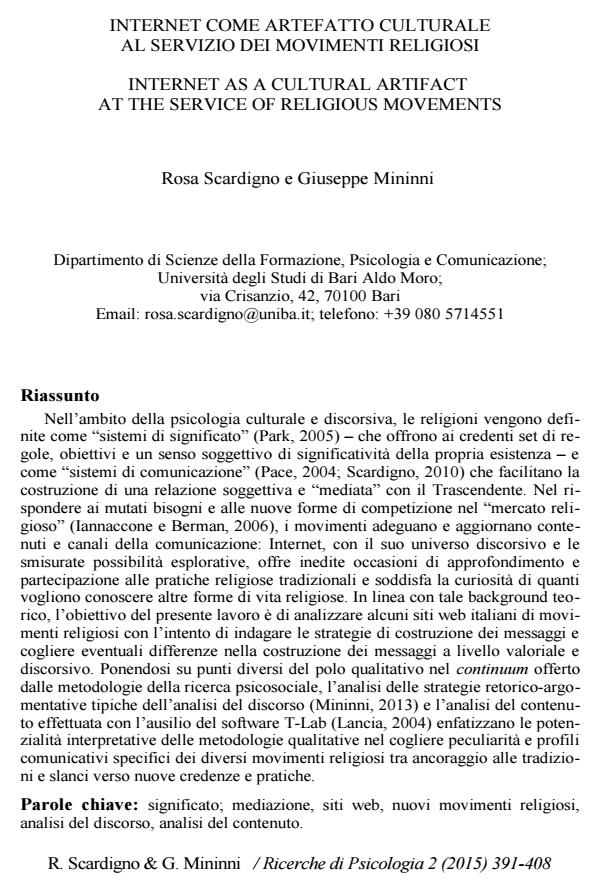Internet come artefatto culturale al servizio dei movimenti religiosi
Titolo Rivista RICERCHE DI PSICOLOGIA
Autori/Curatori Rosa Scardigno, Giuseppe Mininni
Anno di pubblicazione 2015 Fascicolo 2015/2
Lingua Italiano Numero pagine 18 P. 391-408 Dimensione file 192 KB
DOI 10.3280/RIP2015-002008
Il DOI è il codice a barre della proprietà intellettuale: per saperne di più
clicca qui
Qui sotto puoi vedere in anteprima la prima pagina di questo articolo.
Se questo articolo ti interessa, lo puoi acquistare (e scaricare in formato pdf) seguendo le facili indicazioni per acquistare il download credit. Acquista Download Credits per scaricare questo Articolo in formato PDF

FrancoAngeli è membro della Publishers International Linking Association, Inc (PILA)associazione indipendente e non profit per facilitare (attraverso i servizi tecnologici implementati da CrossRef.org) l’accesso degli studiosi ai contenuti digitali nelle pubblicazioni professionali e scientifiche
Nell’ambito della psicologia culturale e discorsiva, le religioni vengono definite come "sistemi di significato" (Park, 2005) - che offrono ai credenti set di regole, obiettivi e un senso soggettivo di significativita della propria esistenza - e come "sistemi di comunicazione" (Pace, 2004; Scardigno, 2010) che facilitano la costruzione di una relazione soggettiva e "mediata" con il Trascendente. Nel rispondere ai mutati bisogni e alle nuove forme di competizione nel "mercato religioso" (Iannaccone e Berman, 2006), i movimenti adeguano e aggiornano contenuti e canali della comunicazione: Internet, con il suo universo discorsivo e le smisurate possibilita esplorative, offre inedite occasioni di approfondimento e partecipazione alle pratiche religiose tradizionali e soddisfa la curiosita di quanti vogliono conoscere altre forme di vita religiose. In linea con tale background teorico, l’obiettivo del presente lavoro e di analizzare alcuni siti web italiani di movimenti religiosi con l’intento di indagare le strategie di costruzione dei messaggi e cogliere eventuali differenze nella costruzione dei messaggi a livello valoriale e discorsivo. Ponendosi su punti diversi del polo qualitativo nel continuum offerto dalle metodologie della ricerca psicosociale, l’analisi delle strategie retorico-argomentative tipiche dell’analisi del discorso (Mininni, 2013) e l’analisi del contenuto effettuata con l’ausilio del software T-Lab (Lancia, 2004) enfatizzano le potenzialita interpretative delle metodologie qualitative nel cogliere peculiarita e profili comunicativi specifici dei diversi movimenti religiosi tra ancoraggio alle tradizioni e slanci verso nuove credenze e pratiche.
Parole chiave:Significato; mediazione, siti web, nuovi movimenti religiosi, analisi del discorso, analisi del contenuto.
Rosa Scardigno, Giuseppe Mininni, Internet come artefatto culturale al servizio dei movimenti religiosi in "RICERCHE DI PSICOLOGIA " 2/2015, pp 391-408, DOI: 10.3280/RIP2015-002008